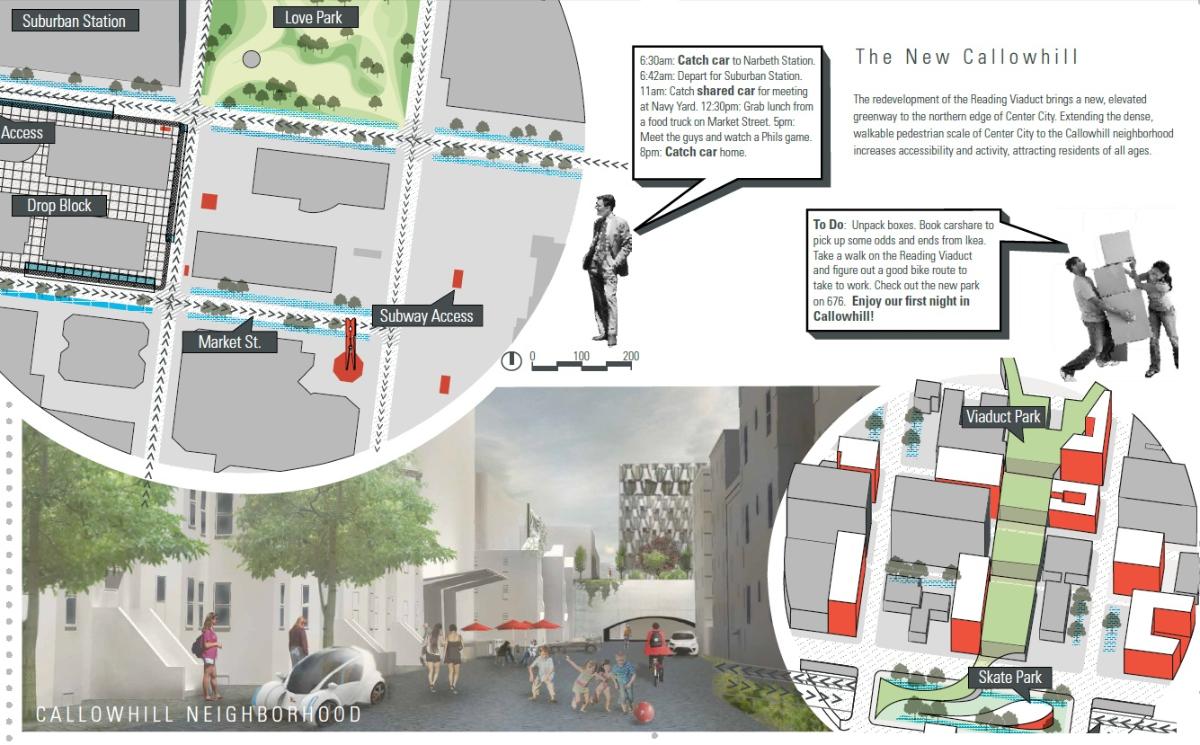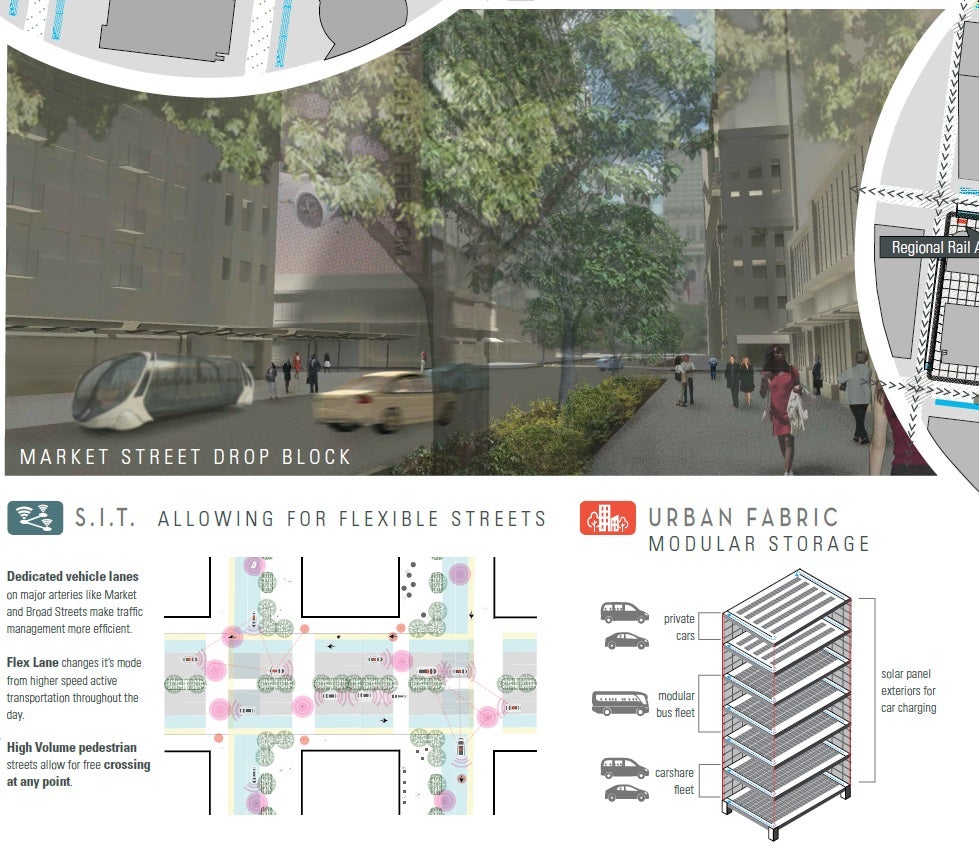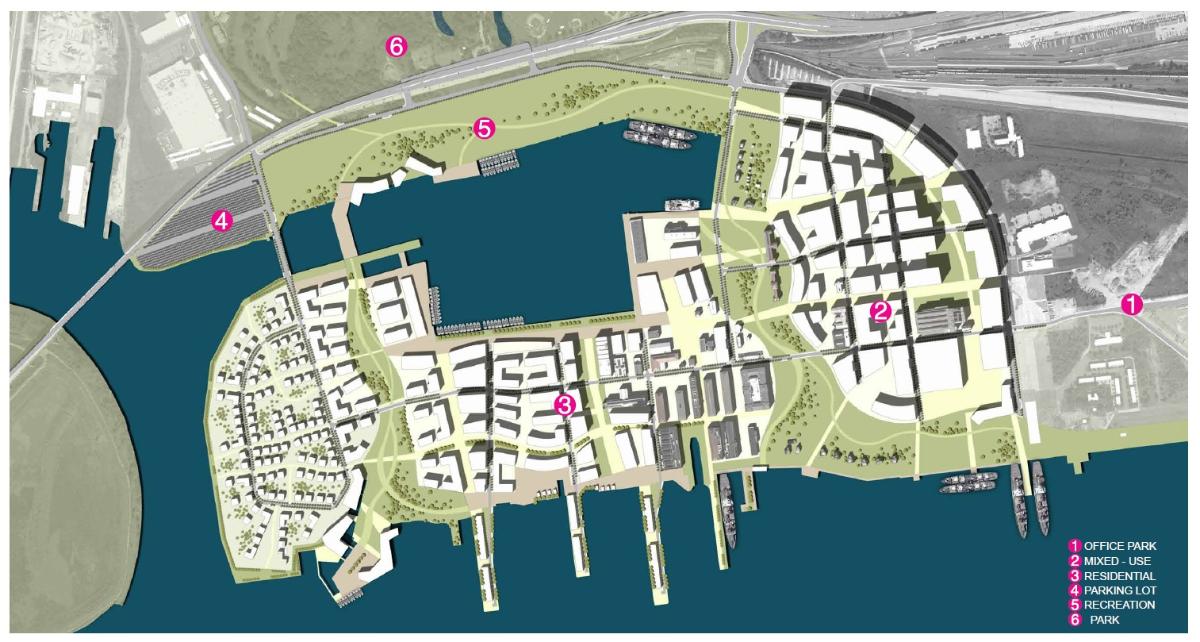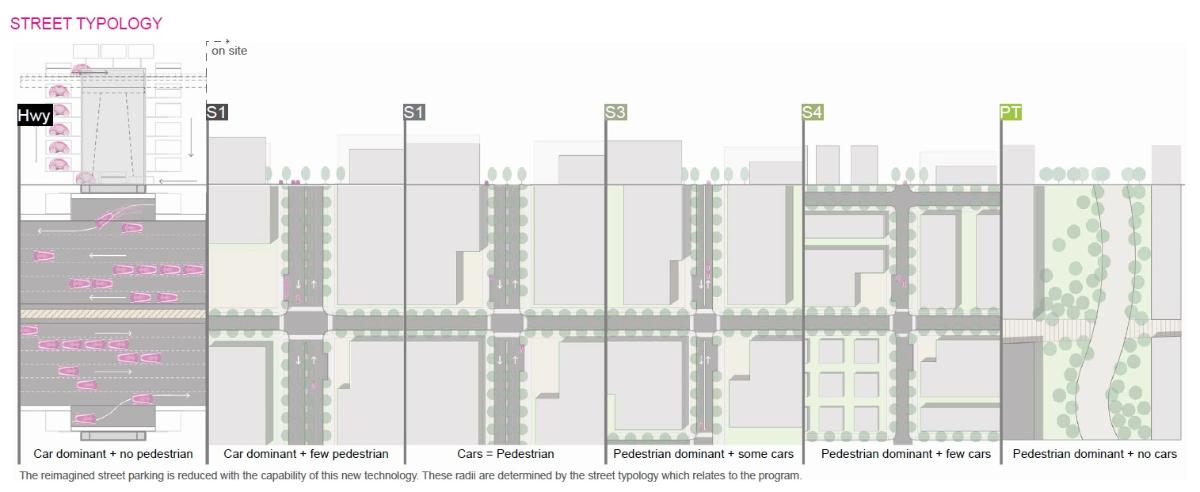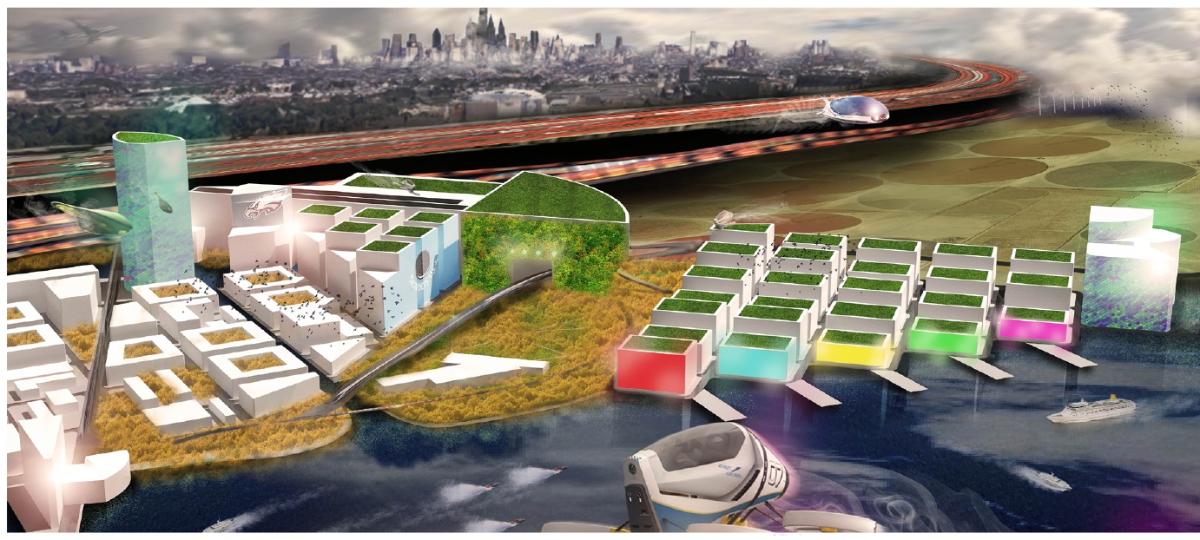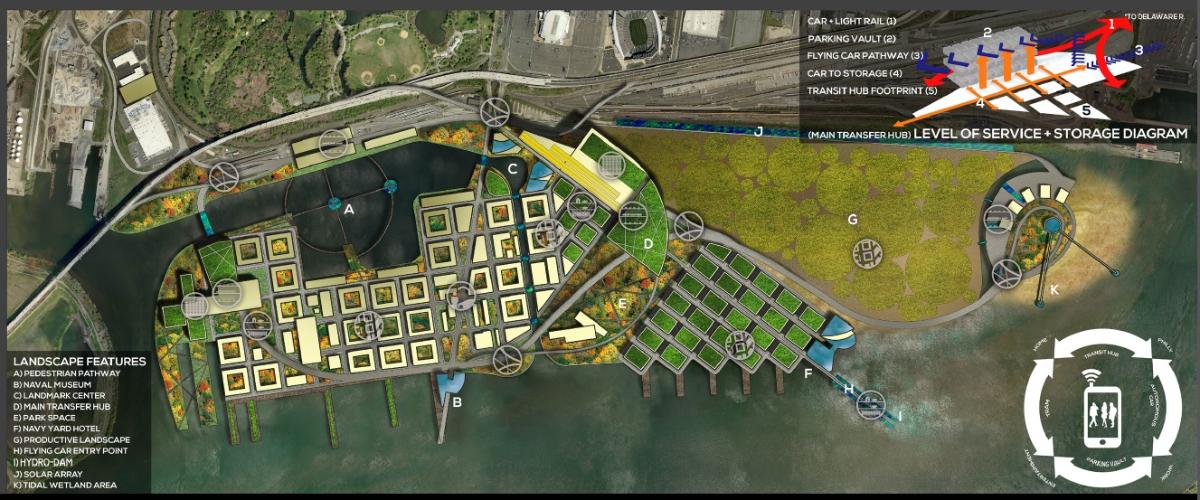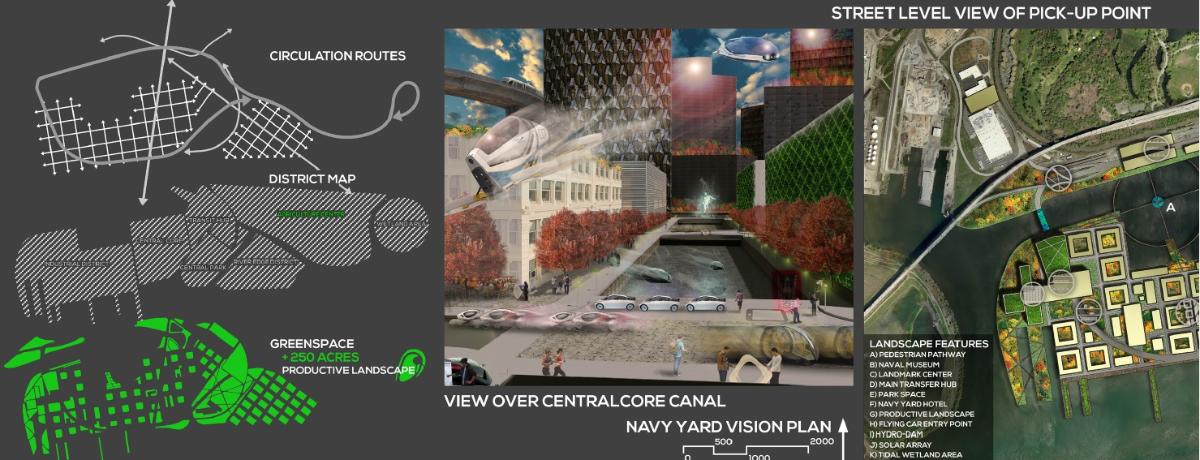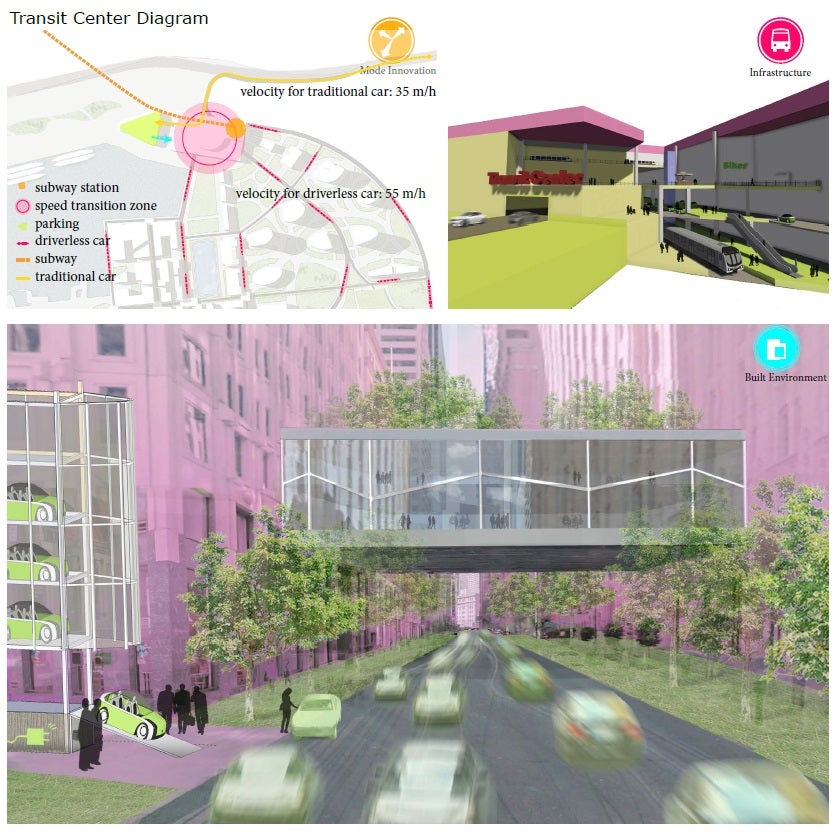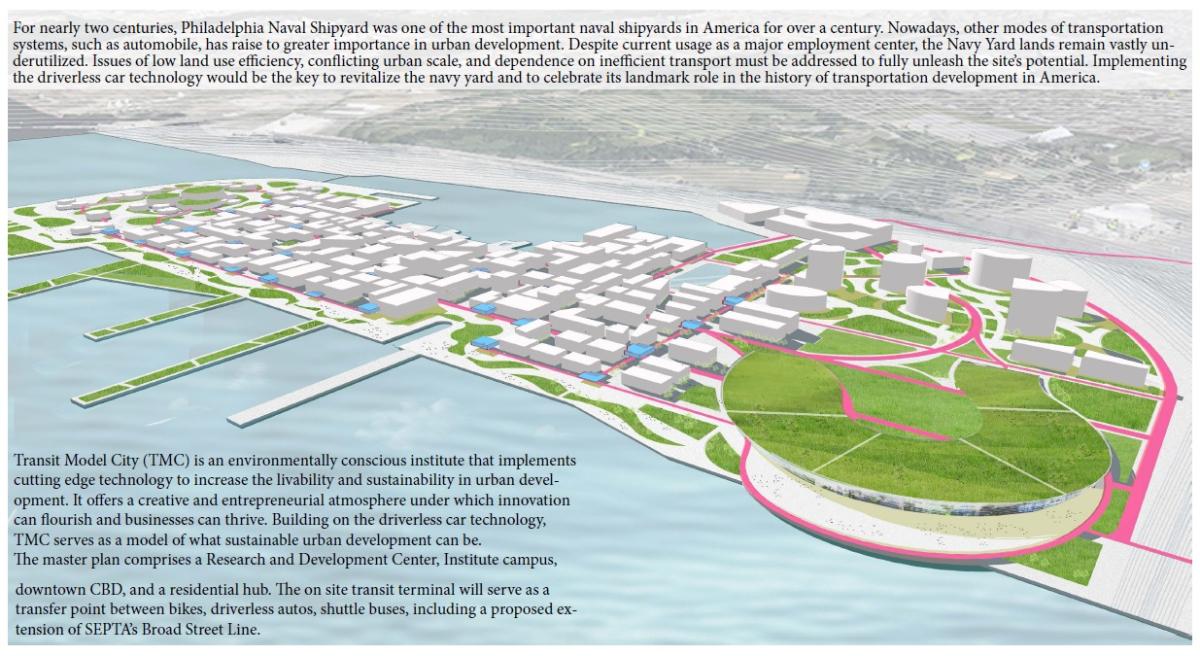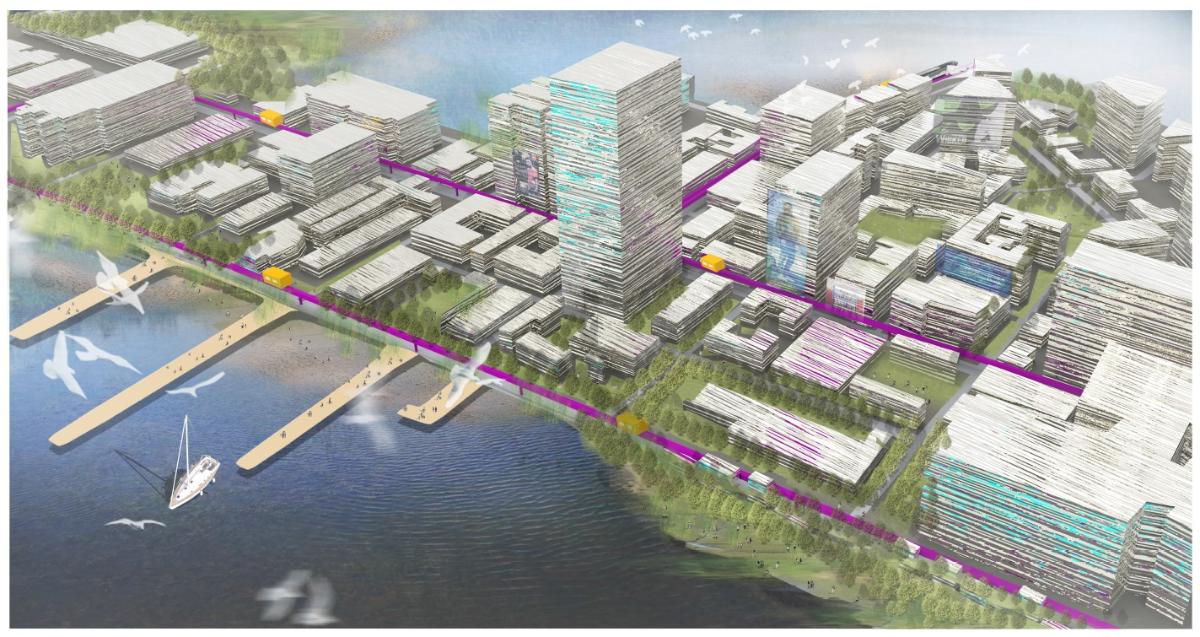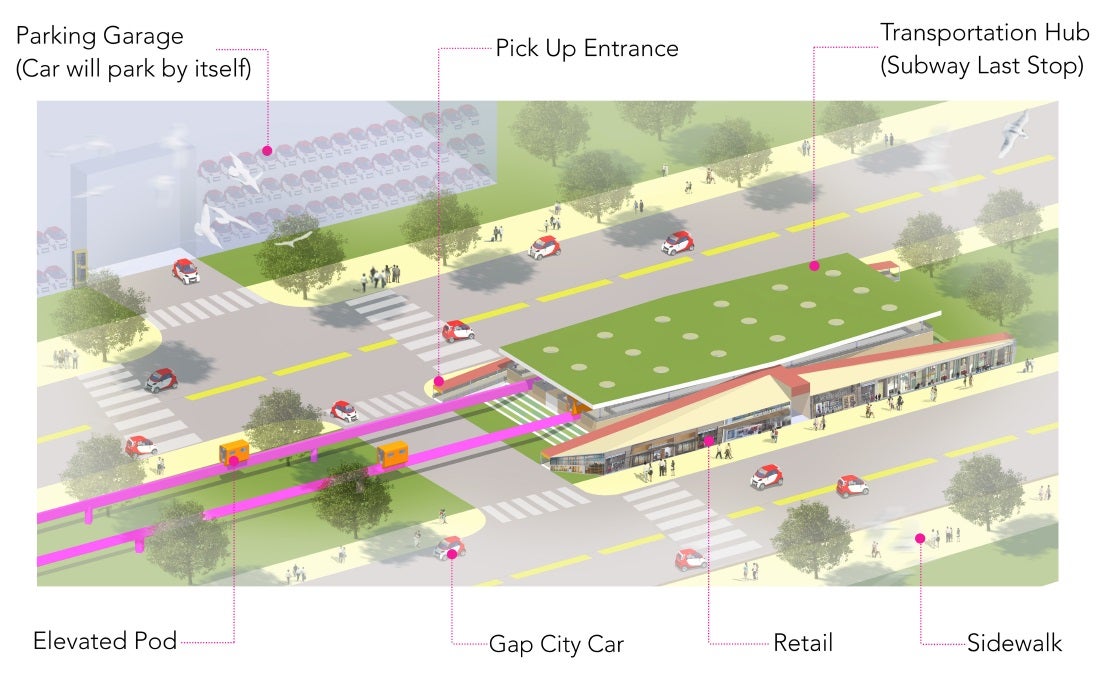Ed Bacon competition examines Philly with driver-less cars
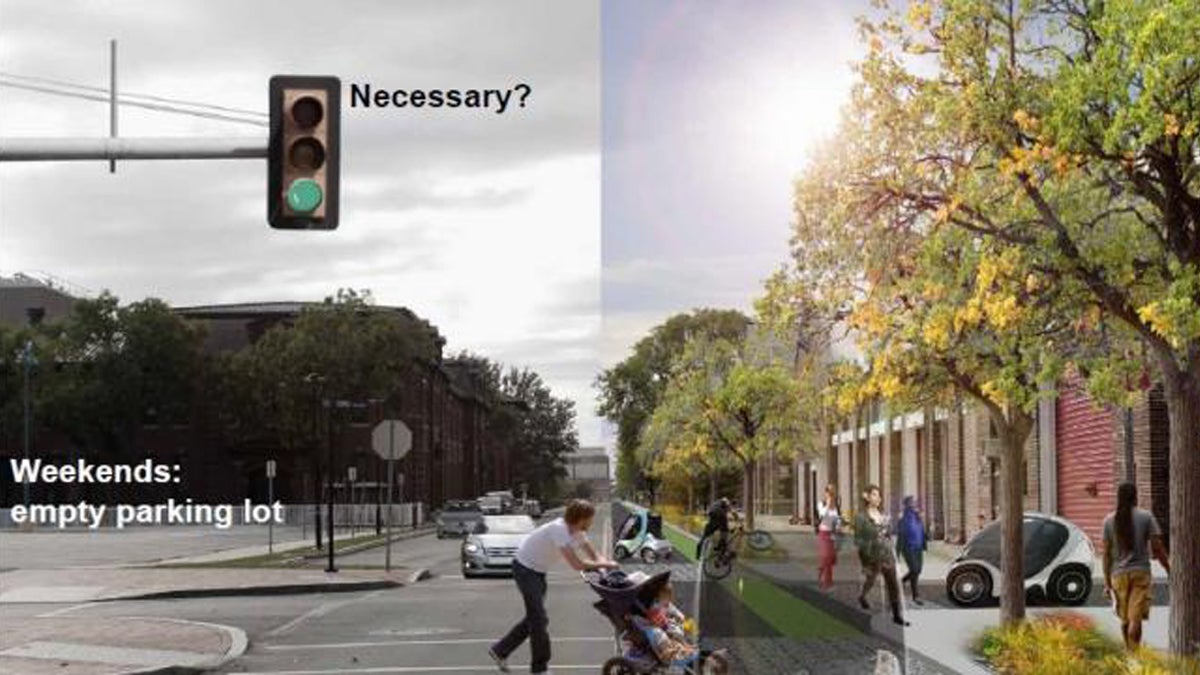
Auto Civitas' vision: With smaller roads, barren parking and driving zones are reinvigorated with green space and wider sidewalks (PlanPhilly Image)
What would life in Philadelphia look like if cars, buses, taxis and other vehicles drove themselves around the city, communicating with each other and with the people who summon them to get to work or play?
This was the question tackled by 15 student teams competing in the Better Philadelphia Challenge – the student competition portion of the Bacon Awards, presented annually by the Philadelphia Center for Architecture. (140 teams from 80 schools and 35 countries registered for the competition, with just 15 producing and submitting a project for judging).
The winning student teams
First prize winner IndePENNdense 2076, from Cornell University, answered with a redesign of the Vine Street corridor in Center City.
Scott Baker, Kate Benisek, Ruslan Filipau, Andrea Haynes and Ashley Pelletier suggested changes across many aspects of transportation. Passengers would use mobile devices to summon various types of vehicles, which pick them up on demand. Public transit buses, as they do today, would carry large numbers of passengers. Carshare owned vans would take smaller groups as would passenger cars with both carshare and private ownership.
In the central business district, vehicles of all types would pick up and drop off people only on designated blocks, easing congestion. In residential neighborhoods, buses are limited to drop-off spots, but all other vehicles could stop anywhere.
These vehicles would not only be communicating with passengers, but with the city streets department. And that allows the city to change the use of some streets – from vehicle priority to pedestrian priority and back again, for example. Use could even be switched by the day or hour. Some zones would allow only autonomous, or driverless, vehicles. Only multi-passenger vehicles would be allowed in the core business district. It would cost more to travel within a congestion pricing zone.
The change to a “pick-up, drop-off culture,” as the IndePENNdense team calls it, means less need for parking in Center City and other neighborhoods. That freed-up space could be used for infill development, putting the “dense” in IndePENNdense.
The jury prize for Best Urban Form went to a local team – the University of Pennsylvania’s Auto Civitas – which imagined what the Navy Yard would be like with a fleet of small, autonomous cars that fold for storage.
A fleet of small cars that fold up to smaller dimensions would be stacked up for storage, freeing much space now used for parking lots, under the plan designed by Zhen Qin and Ida Qu.
Less asphalt means more space for residential and commercial development and parks.
Narrower cars also mean smaller driving lanes, with the extra space given over to pedestrians and bicycles and greenery. Auto Civitas’ vision also includes a car lift that would directly place vehicles on and off of I-95.
The other jury prizes: Most Visionary, the University of Texas at Arlington’s Dylan Stewart and Susan Justus for ECOtonomy; Design of User Experience, The University of Texas at Arlington’s Xitong Li and Karen Teague for Zero-gap Commute; and Integration of Vehicles, Cornell University’s Xiao Hu, Yu Zhu, Sha Huang, Min Bu and Robert Hanifin for Walking The Fast Lane.
Student winners will be honored, and the first place team presented with $5,000, at a Feb. 18 event at the Pennsylvania Convention Center. Go here for details, or to purchase tickets.
See pictures of all the winning entries in the slideshow accompanying this article. Read a Q-n-A with team IndePENNdense and team Auto Civitas in a related story.
Competition jurors talk autonomous vehicles and the future of transportation
The student competition’s three jurors were Dennis Pieprz, principal at Sasaki; Paolo Santi, visiting researcher at MIT Senseable City Lab; and Erick Guerra, assistant professor of City & Regional Planning at the University of Pennsylvania.
The three were impressed not only by the winners’ answers, but by the question itself, one they agree is already being examined by some cities and all automotive manufacturers.
“I think it addressed a subject matter that is very important,” Pieprz said. “I know a lot of entities are looking at this now, looking at the impact.”
Pieprz himself is looking at autonomous vehicles as part of the larger mobility picture. He and a former Sasaki partner have just begun looking on the future of mobility and its impact on cities for car company Audi as part of the Audi Futures experiment. Every year, the company solicits teams to do research on a problem like this, he said.
Santi, who in addition to his work with Senseable Cities is a senior researcher at the Instituto di Informatica e Telematica del CNR in Pisa, Italy, said that based on his work at Senseable City “We’ll really have to change our mind about what traveling with a car will mean. The idea of owning a private car will be changed, because it is not efficient.” Note: Efficiency is Santi’s specialty.
He says we need to open our minds long enough to ask a question: “If you were able to go wherever you want, at whatever time you want, and you don’t have to mess with parking your car, wouldn’t you be happy?”
Santi notes this competition’s time line looks far into the future, but he doesn’t think it will take that long for autonomous vehicles to become a regular part of our lives. The projects looked about 50 years out, but he thinks that future will be here in more like 30 years.
All the major car manufacturers are working behind the scenes on self-driving models, he said.
He sees other small steps toward a re-thought transportation system: Successful carshare programs in Philadelphia, Boston and many other cities; Uber, which allows users in Philadelphia, New York and other cities around the world to request a car with a cell phone app, then watch on a map as the driver arrives.
Guerra points to other beginnings in the shift toward a different transportation system: “We’re already seeing self-parking cars, and some driverless cars.” The Google car, most familiarly.
Changes to cars are coming incrementally, he notes. Some already have the technology to brake without driver input – Hyundai ran adds for its self-braking Genesis during the recent Super Bowl.
Technology isn’t enough to remove people from the driver’s seat, though, Guerra said. “There will need to be legislative changes as well.”
One of the big questions for Guerra is what percentage of vehicles will continue to be owned by individual households in the future. “I do think there’s going to be a lot of car sharing, particularly in a place like Philadelphia,” he said.
Some people will always have their own cars, whether or not they are driving them. The percentage of people who share cars depends largely on how low the price of shared vehicles can go, he said.
If shared car programs and changes to the transportation system get to the point where shared vehicles have an equal or better level of convenience as a private vehicle, many more people in urban areas will gladly give up private cars, he said.
The jurors take on IndePENNdense
Guerra said IndePENNdense was chosen for first prize because “of all the proposals, it was the one that really did the best job of integrating a new technology into an existing urban fabric. It did the best job of getting at how people might interact with the technology, not just the technology in a vacuum, but at how it relates to both people and the city that exists.”
Entrants were allowed to choose from several different potential sites, but Guerra said to him, just choosing part of Center City gave IndePENNdense a bigger challenge, and also made their work more applicable to more cities around the globe. The Navy Yard, for example, is more a “tabula rasa,” he said. But autonomous vehicles “are going to have to integrate into society. We do not have tabula rasas everywhere.”
Guerra noted the IndePENNdense team’s use of congestion zone pricing. Some cities already charge vehicles for driving in their busiest areas, he said. Singapore uses electronic tags to monitor and charge vehicles while London uses cameras to track them. “It becomes a lot easier with autonomous vehicles,” he said. “You wouldn’t need electronic tags, you wouldn’t need cameras. You would already know where every (vehicle) was, and what time it was there.”
Pieprz said while the competition had a single focus, IndePENNdense went beyond it. “I thought the scheme addressed so many issues, it was so full of ideas, that it was worthy of recognition.”
He liked the infill development strategy, and he also complemented the team’s presentation, and how they overlayed different transportation systems. He also liked the narrative examples of how different people would get around in this system. “It shows that they care about how people live in cities, how people use cities, how they navigate the complexities of the city.”
Santi was impressed with IndePENNdense’s thorough analysis of how autonomous vehicles would change city life, and their timeline that showed changes as the technology develops and becomes more prominent over time.
“To redesign the traffic system so there is pick-up and drop-off at specific places is really an interesting concept,” he said.
The jurors on Auto Civitas
Pieprz liked Auto Civitas’ examination of what autonomous vehicles could do to the urban form, looking at what kind of city could be created if less land had to be used for garages and surface parking.
“I thought this was quite well done, integrating existing buildings. They created new districts – each with different expression and character.” The Navy Yard in Auto Civitas’ future vision retains old buildings, but has more density, less pavement and a “more pedestrian-friendly world.”
Pieprz liked that Auto Civitas integrated autonomous vehicles, but did not propose an environment built around them. “It’s not like we’re going to only worry about driverless cars and everything about the future will be driven by that,” he said. “They were still concerned about parks, density, mixed use and a pedestrian environment,” he said, an “environment that is much more driven by a human point of view, in terms of how people use streets, places and open environments.”
With its eyes-on-the-street, balconies, corner shops, cafes, bicycles and trees, “you can see Jane Jacobs in this perspective,” he said.
Guerra also liked the form and human focus. “There’s this idea of a radical and environmentally positive transportation of the city. You get a lot of green space out of it, and in the renderings, most people are walking or biking. The urban form is quite pleasant.” Of all the entries, he said, Auto Civitas created the nicest environment for people.
But he doesn’t think the future with autonomous vehicles will necessarily turn out that way.
“Autonomous vehicles are going to essentially produce a potentially radical increase in road capacity,” he said. In other words: There could be even more cars.
Santi, like the other jurors, mentioned that Auto Civitas used the folding vehicle concept imagined by MIT. “But how they put it in the context of the city was really nice,” he said. He thought the map showing how the system would deliver passengers to spots within a five-minute walk was very helpful.
The five-minute circles illustrate a needed mind-change for the future, he said. If people would give up the door-to-door concept, and be content with being dropped a five-minute walk from their destination, the entire transportation system could move many more people much more efficiently, he said.
Professional Award Winner: Former Governor and Mayor Ed Rendell
The 8th annual Edmund N. Bacon Prize, awarded by the Center for Architecture to “an accomplished figure who, like Bacon, has achieved outstanding success in urban planning, development, and design through conviction of vision, effective communication, and a commitment to improving their community,” goes to Ed Rendell, who will give a talk at the Feb. 18 ceremony.
Rendell was chosen, “for his ongoing efforts to promote smart transportation investment and development,” according to the press release.
Rendell “is well-known both locally and nationally as one of the foremost advocates for serious investment in transportation infrastructure, as has been evidenced through his tenure as Mayor of Philadelphia,
In 2008 Rendell co-founded Building America’s Future, a bipartisan coalition of elected officials dedicated to ‘bringing about a new era of U.S. investment in infrastructure that enhances our nation’s prosperity and quality of life,’” the press release states.
The past winners: John Hickenlooper, Governor of the State of Colorado; Janette Sadik-Khan, NYC Commissioner of Transportation; Denise Scott Brown, planner and author; Maurice Cox, former mayor of Charlottesville, VA; John O. Norquist, former Mayor of Milwaukee and founder of the Congress for New Urbanism; Paul Goldberger, Architecture Critic for The New Yorker magazine; and Robert A.M. Stern, architect and Dean of the Yale School of Architecture.
Click through to view conceptual renderings on PlanPhilly.
WHYY is your source for fact-based, in-depth journalism and information. As a nonprofit organization, we rely on financial support from readers like you. Please give today.
Ed Bacon competition examines Philly with driver-less cars
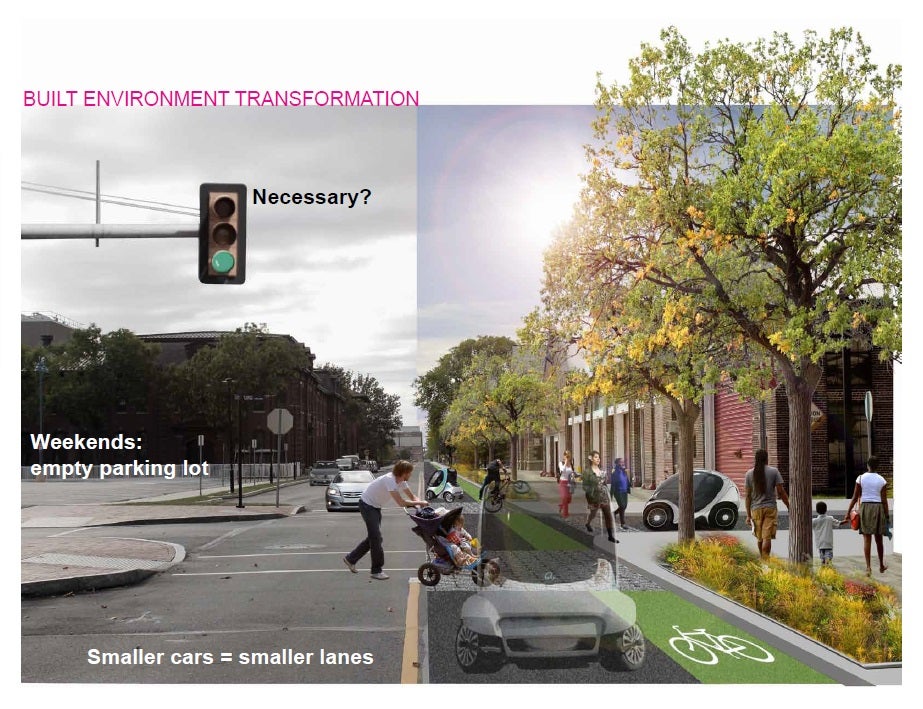
Student winners include teams from Cornell, Penn and the University of Texas; Former Mayor and Governor Rendell gets Edmund N. Bacon Prize
What would life in Philadelphia look like if cars, buses, taxis and other vehicles drove themselves around the city, communicating with each other and with the people who summon them to get to work or play?
This was the question tackled by 15 student teams competing in the Better Philadelphia Challenge – the student competition portion of the Bacon Awards, presented annually by the Philadelphia Center for Architecture. (140 teams from 80 schools and 35 countries registered for the competition, with just 15 producing and submitting a project for judging).
The winning student teams
First prize winner IndePENNdense 2076, from Cornell University, answered with a redesign of the Vine Street corridor in Center City.
Scott Baker, Kate Benisek, Ruslan Filipau, Andrea Haynes and Ashley Pelletier suggested changes across many aspects of transportation. Passengers would use mobile devices to summon various types of vehicles, which pick them up on demand. Public transit buses, as they do today, would carry large numbers of passengers. Carshare owned vans would take smaller groups as would passenger cars with both carshare and private ownership.
In the central business district, vehicles of all types would pick up and drop off people only on designated blocks, easing congestion. In residential neighborhoods, buses are limited to drop-off spots, but all other vehicles could stop anywhere.
These vehicles would not only be communicating with passengers, but with the city streets department. And that allows the city to change the use of some streets – from vehicle priority to pedestrian priority and back again, for example. Use could even be switched by the day or hour. Some zones would allow only autonomous, or driverless, vehicles. Only multi-passenger vehicles would be allowed in the core business district. It would cost more to travel within a congestion pricing zone.
The change to a “pick-up, drop-off culture,” as the IndePENNdense team calls it, means less need for parking in Center City and other neighborhoods. That freed-up space could be used for infill development, putting the “dense” in IndePENNdense.
The jury prize for Best Urban Form went to a local team – the University of Pennsylvania’s Auto Civitas – which imagined what the Navy Yard would be like with a fleet of small, autonomous cars that fold for storage.
A fleet of small cars that fold up to smaller dimensions would be stacked up for storage, freeing much space now used for parking lots, under the plan designed by Zhen Qin and Ida Qu.
Less asphalt means more space for residential and commercial development and parks.
Narrower cars also mean smaller driving lanes, with the extra space given over to pedestrians and bicycles and greenery. Auto Civitas’ vision also includes a car lift that would directly place vehicles on and off of I-95.
The other jury prizes: Most Visionary, the University of Texas at Arlington’s Dylan Stewart and Susan Justus for ECOtonomy; Design of User Experience, The University of Texas at Arlington’s Xitong Li and Karen Teague for Zero-gap Commute; and Integration of Vehicles, Cornell University’s Xiao Hu, Yu Zhu, Sha Huang, Min Bu and Robert Hanifin for Walking The Fast Lane.
Student winners will be honored, and the first place team presented with $5,000, at a Feb. 18 event at the Pennsylvania Convention Center. Go here for details, or to purchase tickets.
See pictures of all the winning entries in the slideshow accompanying this article. Read a Q-n-A with team IndePENNdense and team Auto Civitas in a related story.
Competition jurors talk autonomous vehicles and the future of transportation
The student competition’s three jurors were Dennis Pieprz, principal at Sasaki; Paolo Santi, visiting researcher at MIT Senseable City Lab; and Erick Guerra, assistant professor of City & Regional Planning at the University of Pennsylvania.
The three were impressed not only by the winners’ answers, but by the question itself, one they agree is already being examined by some cities and all automotive manufacturers.
“I think it addressed a subject matter that is very important,” Pieprz said. “I know a lot of entities are looking at this now, looking at the impact.”
Pieprz himself is looking at autonomous vehicles as part of the larger mobility picture. He and a former Sasaki partner have just begun looking on the future of mobility and its impact on cities for car company Audi as part of the Audi Futures experiment. Every year, the company solicits teams to do research on a problem like this, he said.
Santi, who in addition to his work with Senseable Cities is a senior researcher at the Instituto di Informatica e Telematica del CNR in Pisa, Italy, said that based on his work at Senseable City “We’ll really have to change our mind about what traveling with a car will mean. The idea of owning a private car will be changed, because it is not efficient.” Note: Efficiency is Santi’s specialty.
He says we need to open our minds long enough to ask a question: “If you were able to go wherever you want, at whatever time you want, and you don’t have to mess with parking your car, wouldn’t you be happy?”
Santi notes this competition’s time line looks far into the future, but he doesn’t think it will take that long for autonomous vehicles to become a regular part of our lives. The projects looked about 50 years out, but he thinks that future will be here in more like 30 years.
All the major car manufacturers are working behind the scenes on self-driving models, he said.
He sees other small steps toward a re-thought transportation system: Successful carshare programs in Philadelphia, Boston and many other cities; Uber, which allows users in Philadelphia, New York and other cities around the world to request a car with a cell phone app, then watch on a map as the driver arrives.
Guerra points to other beginnings in the shift toward a different transportation system: “We’re already seeing self-parking cars, and some driverless cars.” The Google car, most familiarly.
Changes to cars are coming incrementally, he notes. Some already have the technology to brake without driver input – Hyundai ran adds for its self-braking Genesis during the recent Super Bowl.
Technology isn’t enough to remove people from the driver’s seat, though, Guerra said. “There will need to be legislative changes as well.”
One of the big questions for Guerra is what percentage of vehicles will continue to be owned by individual households in the future. “I do think there’s going to be a lot of car sharing, particularly in a place like Philadelphia,” he said.
Some people will always have their own cars, whether or not they are driving them. The percentage of people who share cars depends largely on how low the price of shared vehicles can go, he said.
If shared car programs and changes to the transportation system get to the point where shared vehicles have an equal or better level of convenience as a private vehicle, many more people in urban areas will gladly give up private cars, he said.
The jurors take on IndePENNdense
Guerra said IndePENNdense was chosen for first prize because “of all the proposals, it was the one that really did the best job of integrating a new technology into an existing urban fabric. It did the best job of getting at how people might interact with the technology, not just the technology in a vacuum, but at how it relates to both people and the city that exists.”
Entrants were allowed to choose from several different potential sites, but Guerra said to him, just choosing part of Center City gave IndePENNdense a bigger challenge, and also made their work more applicable to more cities around the globe. The Navy Yard, for example, is more a “tabula rasa,” he said. But autonomous vehicles “are going to have to integrate into society. We do not have tabula rasas everywhere.”
Guerra noted the IndePENNdense team’s use of congestion zone pricing. Some cities already charge vehicles for driving in their busiest areas, he said. Singapore uses electronic tags to monitor and charge vehicles while London uses cameras to track them. “It becomes a lot easier with autonomous vehicles,” he said. “You wouldn’t need electronic tags, you wouldn’t need cameras. You would already know where every (vehicle) was, and what time it was there.”
Pieprz said while the competition had a single focus, IndePENNdense went beyond it. “I thought the scheme addressed so many issues, it was so full of ideas, that it was worthy of recognition.”
He liked the infill development strategy, and he also complemented the team’s presentation, and how they overlayed different transportation systems. He also liked the narrative examples of how different people would get around in this system. “It shows that they care about how people live in cities, how people use cities, how they navigate the complexities of the city.”
Santi was impressed with IndePENNdense’s thorough analysis of how autonomous vehicles would change city life, and their timeline that showed changes as the technology develops and becomes more prominent over time.
“To redesign the traffic system so there is pick-up and drop-off at specific places is really an interesting concept,” he said.
The jurors on Auto Civitas
Pieprz liked Auto Civitas’ examination of what autonomous vehicles could do to the urban form, looking at what kind of city could be created if less land had to be used for garages and surface parking.
“I thought this was quite well done, integrating existing buildings. They created new districts – each with different expression and character.” The Navy Yard in Auto Civitas’ future vision retains old buildings, but has more density, less pavement and a “more pedestrian-friendly world.”
Pieprz liked that Auto Civitas integrated autonomous vehicles, but did not propose an environment built around them. “It’s not like we’re going to only worry about driverless cars and everything about the future will be driven by that,” he said. “They were still concerned about parks, density, mixed use and a pedestrian environment,” he said, an “environment that is much more driven by a human point of view, in terms of how people use streets, places and open environments.”
With its eyes-on-the-street, balconies, corner shops, cafes, bicycles and trees, “you can see Jane Jacobs in this perspective,” he said.
Guerra also liked the form and human focus. “There’s this idea of a radical and environmentally positive transportation of the city. You get a lot of green space out of it, and in the renderings, most people are walking or biking. The urban form is quite pleasant.” Of all the entries, he said, Auto Civitas created the nicest environment for people.
But he doesn’t think the future with autonomous vehicles will necessarily turn out that way.
“Autonomous vehicles are going to essentially produce a potentially radical increase in road capacity,” he said. In other words: There could be even more cars.
Santi, like the other jurors, mentioned that Auto Civitas used the folding vehicle concept imagined by MIT. “But how they put it in the context of the city was really nice,” he said. He thought the map showing how the system would deliver passengers to spots within a five-minute walk was very helpful.
The five-minute circles illustrate a needed mind-change for the future, he said. If people would give up the door-to-door concept, and be content with being dropped a five-minute walk from their destination, the entire transportation system could move many more people much more efficiently, he said.
Professional Award Winner: Former Governor and Mayor Ed Rendell
The 8th annual Edmund N. Bacon Prize, awarded by the Center for Architecture to “an accomplished figure who, like Bacon, has achieved outstanding success in urban planning, development, and design through conviction of vision, effective communication, and a commitment to improving their community,” goes to Ed Rendell, who will give a talk at the Feb. 18 ceremony.
Rendell was chosen, “for his ongoing efforts to promote smart transportation investment and development,” according to the press release.
Rendell “is well-known both locally and nationally as one of the foremost advocates for serious investment in transportation infrastructure, as has been evidenced through his tenure as Mayor of Philadelphia,
In 2008 Rendell co-founded Building America’s Future, a bipartisan coalition of elected officials dedicated to ‘bringing about a new era of U.S. investment in infrastructure that enhances our nation’s prosperity and quality of life,’” the press release states.
The past winners: John Hickenlooper, Governor of the State of Colorado; Janette Sadik-Khan, NYC Commissioner of Transportation; Denise Scott Brown, planner and author; Maurice Cox, former mayor of Charlottesville, VA; John O. Norquist, former Mayor of Milwaukee and founder of the Congress for New Urbanism; Paul Goldberger, Architecture Critic for The New Yorker magazine; and Robert A.M. Stern, architect and Dean of the Yale School of Architecture.
WHYY is your source for fact-based, in-depth journalism and information. As a nonprofit organization, we rely on financial support from readers like you. Please give today.


